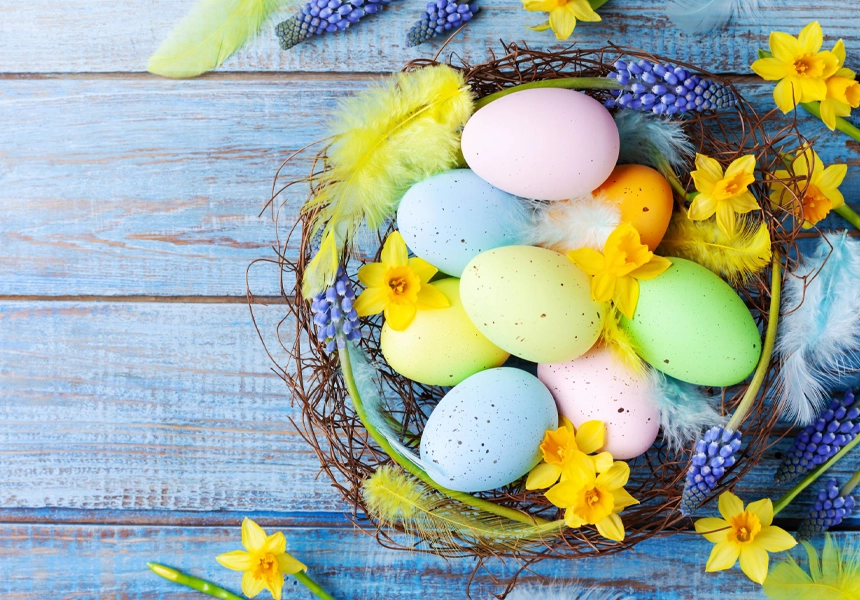Topical Talkers
Intersting Facts About Easter.
Easter means many different things to many people, according to a person’s origin, faith, creed and (in my case) a love of chocolate (OK, OK! I’m not afraid to admit it!).
Easter is not just about Christianity, there is much more to it than that! So, whatever your beliefs, to celebrate here are some interesting facts about Easter.

The origin of the name, Easter.
The name Easter owes its origin from Eastre, the Anglo-Saxon goddess who symbolizes hare and egg. Eastre is often spelt Eostre, Oestre or Ostara. Ostara is also a northern European name for Astarte, which means “womb”, and is another name for Venus, the goddess of love, passion, and creativity.
Why we paint and decorate eggs for Easter.
The art of painting and decorating eggs is known as “Pysanka”. The brightly coloured eggs are symbolic of spring flowers and the new beginnings. It is said that King Edward I of England may also have contributed to the tradition of decorating eggs to celebrate Easter. In the 13th century, Edward I ordered 450 eggs to be coloured and decorated with gold-leaf. They were presented as Easter gifts to the rest of the royal household. In Christianity, Easter Eggs are coloured red to symbolise the blood of Jesus.
Why we associate a bunny at Easter.
The Easter Bunny originates from paintings of the Anglo Saxon Goddess Eastre, who was always depicted holding a hare. Originally it was the Easter Hare, but this has evolved to be the Easter Bunny, I can only presume because, on the whole, bunnies are a little bit cuter than hares and are more appealing to children?
Where the first chocolate Easter Eggs made.
Chocolate eggs are said to have originated in France and Germany in the early 19th century. Progress in the chocolate Easter egg market was very slow until 1893 when Cadbury created the first modern chocolate Easter egg after developing a chocolate that could be poured into moulds. Made of dark chocolate, the eggs had a smooth surface and were filled with sweets.
Cadbury Creme Eggs originally had a different name.
Some of us cannot imagine an Easter without Cadbury eggs, so to think they were almost called something else is crazy! The filled egg was first invented in 1923, but it wasn’t until 1963 when they started to be sold under the name Fry’s Creme Eggs. Then, the name changed again to Cadbury Creme Eggs in 1971. Even more impressive is that the Bournville factory in Birmingham, England, churns out 500 million of the cream-filled eggs every year.
The reason Easter changes dates every year.
You’ve probably noticed that the date of Easter moves around quite a bit. Sometimes it comes at the end of March; other years it happens in late April. Easter is always on the first Sunday after the first full moon that follows the spring equinox. But this full moon is an ecclesiastical full moon (ecclesiastical means ‘of the Church’), and so wasn’t calculated in quite the same way modern astronomers would.
On top of that, for the purpose of calculating Easter, the spring equinox is always on 21 March.
In 2024, the first Sunday after the first full moon following the 21 March is Sunday 31 March.
Eating Lamb is a tradition at Easter.
The eating of lamb on Easter Sunday goes back further than Easter and is connected to Passover, a Jewish festival.
Passover celebrate the Israelites being freed from slavery and at then end of passover a ‘Passover lamb’ is eaten.
It is likely that Jews who converted to Christianity kept the tradition of eating a lamb but rather than eat it on Passover they ate it on Easter Sunday.
Easter fun ideas for the whole family.
Easter is a time of joy and celebration, and what better way to enjoy the season than with a range of activities that the whole family can enjoy? Whether you’re looking to spend time outdoors basking in the spring sun or prefer to stay cozy inside, we’ve got some egg-cellent ideas for all ages.
- Classic Easter Egg Hunt: Prepare for squeals of delight with a traditional egg hunt in your backyard. Hide eggs filled with treats or small toys and watch the children’s excitement as they search for their hidden treasures.
- Indoor Egg Hunt: Don’t let bad weather stop the fun. Hide eggs around the house and leave clues for kids to find them. You can even make it educational by including riddles that need to be solved to locate the next egg.
- Bunny Hop Race: Have a hopping good time with a bunny hop sack race! Use pillowcases or sacks and see who can jump to the finish line the fastest while keeping in their "bunny" character.
- Egg and Spoon Race: Challenge your family’s balance and coordination with an egg and spoon race. Use hard-boiled eggs for less mess, or if you’re feeling daring, raw eggs!
- Easter Nature Scavenger Hunt: Make a list of springtime items for families to find, like blossom flowers, spring insects, and different colored pebbles. This activity is perfect for enjoying and appreciating nature.
- Movie Marathon: Relax with a collection of family-friendly Easter movies or spring-themed films. Don’t forget the popcorn and maybe some chocolate Easter eggs to munch on! No matter what activities you choose, the key is to spend quality time together as a family, creating memories that will last a lifetime. Have a wonderful Easter!